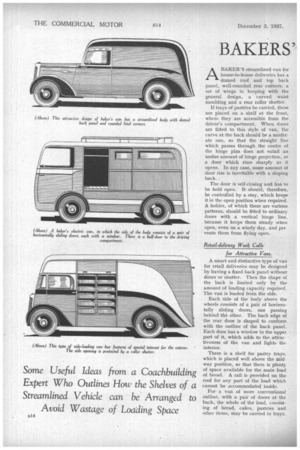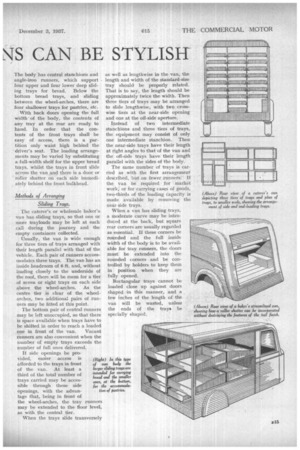BAKERS' NS CAN BE STYLISH
Page 12

Page 13

If you've noticed an error in this article please click here to report it so we can fix it.
ABAKER'S streamlined van for house-to-house deliveries has a domed roof and top back panel, well-rounded rear corners, a set of wings in keeping with the general design, a curved waist moulding and a rear roller shutter.
If trays of pastries be carried, these are placed on a shelf at the front, where they are accessible from the driver's compartment. When doors are fitted to this style of van, the curve at the back should be a moderate one, so that the straight line which passes through the centre of the hinge pins does not entail an undue amount of hinge projection, or a door which rises sharply as it opens. In any case, some amount of door rise is inevitable with a sloping back..
The door is self-closing and has to be held open. It should, therefore, be controlled by a stay, which keeps it in the open position when required. 4 holder, of which there are various patterns, should be fitted to ordinary doors with a vertical hinge line, because it keeps them steady when open, even on a windy day, and prevents them from flying open.
Retail-delivery Work Calls for Attractive Vans.
A smart and distinctive type of van for retail deliveries may be designed by having a fixed back panel without doors or shutter. Then the shape of the back is limited only by the amount of loading capacity required. The van is loaded from the side.
Each side of the body above the wheels consists of a pair of horizontally sliding doors„ one passing behind the other. The back edge of the rear door is shaped to conform with the outline of the back panel. Each door has a window in the upper part of it, which adds to the attrac tiveness of the van and lights the interior.
There is a shelf for pastry trays, which is placed well above the midway position, so that there is plenty of space available for the main load of bread. A rail is provided on the roof for any part of the load which cannot be accommodated inside.
For a van of more conventional outline, with a pair of doors at the back, the whole of the load, consisting of bread, cakes, pastries and other items, may be carried in trays. The body has central stanchions and angle-iron runners, which support four upper and four lower deep sliding trays for bread. Below the bottom bread trays, and sliding between the wheel-arches, there are four shallower trays for pastries, etc.
With back doors opening the full width' of the body, the contents of any tray at the rear are ready to hand. In order that the contents of the front trays shall be easy of access, there is a partition only waist high behind the driver's seat. The loading arrangements may be varied by substituting a full-width shelf for the upper bread trays, whilst the trays in front slide across the van a,nd there is a door or , . roller shutter on each side immediately behind the front bulkhead.
Methods of Arranging
Sliding Trays.
The caterer's or wholesale baker'svan has sliding trays, so that one or more trayloads may be left at each call during the journey and the empty containers collected.
Usually, the van is wide enough for three tiers of trays arranged with their length parallel with that of the vehicle. Each pair of runners accommodates three trays. The van has an inside headroom of 6 ft. and, without loading closely to the underside of the roof, there mill be room for a tier of seven or eight trays on each side above the wheel-arches. As the centre tier is clear of the wheelarches, two additional pairs of runners may be fitted at this point.
The bottom pair of central runners may be left unoccupied, so that there is space available when trays have to be shifted in order to reach a loaded one in front of the van. Vacant runners are also convenient when the number of empty trays exceeds the number of full ones delivered.
If side openings be provided, easier access is afforded to the trays in front of the van. At least a third of the total number of trays carried may be accessible through these side openings, with the advantage that, being in front of the wheel-arches, the tray runners may be extended to the floor level, as with the central tier.
When the trays slide transversely
as well as lengthwise in the van, the length and width of the standard-size tray should be properly related. That is to say, the length should be approximately twice the width. Then three tiers of trays may be arranged to slide lengthwise, with two crosswise tiers at the near-side opening and one at the off-side aperture.
Instead of two intermediate stanchions and three tiers of trays, the equipment may consist of only one intermediate stanchion. Then the near-side trays have their length at right angles to that of the van and the off-side trays have their length parallel with the sides of the body.
The same number of trays is carried as with the first arrangement described, but on fewer runners.If the van be' required for _Market work, or for carrying cases of ,goods, two-thirds of the loading capacity is made available by removing the near-side trays.
When a van has sliding trays, a moderate curve may be introduced at the back, but square rear corners are usually regarded as essential. If these corners be rounded and the full inside width of the body is to be available for tray runners, the doors must be extended into the rounded corners and be controlled by holders to keep them in position when they are fully opened.
Rectangular trays cannot be loaded close up against doors shaped in this manner, and a few inches of the length of the van will be wasted, unless the ends of the trays be specially shaped.


































